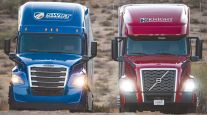Overseas Low-Cost Truck Manufacturers Could Help U.S. Carriers, Consultant Says
This story appears in the Jan. 17 print edition of Transport Topics.
The global low-cost truck market will make less-expensive vehicles available in North America, which has seen prices rising steadily for more than a decade, said a new report from consulting firm Frost & Sullivan.
The low-cost movement could take the shape of new heavy-duty trucks costing less than $100,000 each in North America, manufactured by European or North American producers in partnerships with companies from the so-called BRIC nations — Brazil, Russia, India and China.
Sandeep Kar, an F&S manager in Toronto, compared the advent of overseas-made heavy trucks to the North American market with Toyota’s launch into the United States to compete with General Motors, Ford and Chrysler.
“I think this is similar to the late 1960s when Detroit was doing well until Toyota came in. The Detroit Three said the Japanese made ‘cheap’ cars, but they were really just cost-efficient,” said Kar.
He spoke with Transport Topics about the Frost & Sullivan study ahead of its scheduled Jan. 17 release at Heavy-Duty Dialogue in Las Vegas.
While the cheapest of the low-cost trucks will remain in the developing world, even U.S. and Canadian fleet managers will have access to some of these vehicles — providing they are looking for a plain vanilla truck, Kar said.
The Frost & Sullivan report estimates a global manufacturing volume of 3.2 million low-cost units in 2016 — light-, medium- and heavy-duty — up from 1.8 million low-cost units manufactured in 2009, a very poor sales year. That’s an 8.6% average annual growth rate.
In terms of North American exposure, the report estimates 130,000 light-, medium- and heavy-duty trucks a year by 2016, up from 44,000 in 2009. To place that in context, in 2007, U.S. businesses bought 537,000 Class 3-8 trucks, according to WardsAuto.com.
The F&S report mentions Daimler Trucks and Navistar Inc. as two original equipment manufacturers with large global presences in the low-cost arena, and companies well-positioned to bring the vehicles to North America. However, when asked about the report, the OEMs neither endorsed it nor disparaged it.
“We’ve got a lot of things in the works, but I can’t tell you about them because our competition would just love to know, so stay tuned,” said Navistar Inc. spokesman Roy Wiley.
Navistar has a well-known partnership with India’s Mahindra Group, but Wiley said that activity has been concentrated so far on India and other Asian markets, not North America.
The F&S report said Daimler Trucks will work with other OEMs and launch a “Brand X” in 2012 to generate sales in the low-cost market but not under its current Freightliner or Mercedes-Benz brands.
“We haven’t seen the study as yet, but I can assure you that there are no plans to introduce a new truck brand and product in the U.S.,” said Daimler Trucks North America spokeswoman Amy Sills.
However, Daimler is very interested the BRIC nations, as Daimler Trucks’ global chief Andreas Renschler discussed business and opportunities there with TT editors at the Mid-America Trucking Show in March and again at American Trucking Associations’ Management Conference & Exhibition in October.
Asked to put some flesh on the bones of the concept, Kar said a low-cost, heavy-duty North American truck would have an 8-liter to 10-liter engine with 240 to 280 horsepower. In contrast, many fleets currently choose between 13-liter and 15-liter engines with more than 400 horsepower.
As for creature comforts, throw them all away, Kar said. “It means removing all of the extra bells and whistles that aren’t necessary,” including air-conditioning, he said.
The trucks would have to meet U.S. emissions and safety regulations, and that means a truck that would cost about $50,000 in India would go for $80,000 to $90,000 here, Kar said.
Such a vehicle could be used by a parcel courier or private fleet for distribution within a metropolitan area or within parts of a densely packed region. Longhaul carriers with the heaviest of loads would probably have no interest, he said. Those carriers will probably stick with modern U.S. tractors, which go for about $120,000 each when new.
Asked about quality, Kar said a low-cost truck cannot match up directly with models displayed in Louisville at Mid-America, but India’s Tata does source parts from vendors such as Cummins Inc. for engines; Hendrickson International; Knorr Bremse, the parent of Bendix Commercial Vehicle Systems; and other well-known suppliers.
“It’s nothing in North America now, but it’s coming and it will grow,” Kar said, adding that one of his colleagues will offer a more detailed presentation at Heavy-Duty Dialogue.




